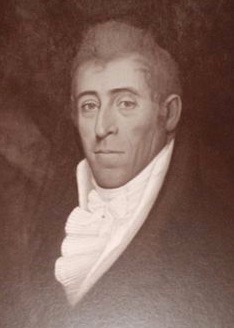
Dr. Daniel Adams
What is now the Town of China was settled in 1774, starting on the shores of China Lake, and promptly incorporated as Jones Plantation.
On Feb. 8, 1796, the Massachusetts legislature made it a town named Harlem. On Feb. 5, 1818, the legislature incorporated southern Albion and northern Harlem into a town named China. In January 1822, after much local debate, the Maine legislature added the rest of Harlem to China.
The China bicentennial history says Harlem’s first school opened in 1795, before the town existed officially. It was on the east side of China Lake, either in a house or in a log cabin built especially for a school; Rev. Job Chadwick was the teacher.
Orrin Sproul, who wrote a section on China’s schools in Henry Kingsbury’s Kennebec County history, said Chadwick taught for several successive terms.
At the second Harlem town meeting, in June 1796, voters raised $200 for schools (and $300 for roads) and instructed the selectmen and constable to allocate the money. As in other towns, school districts were created, and frequently rearranged. The bicentennial history says there were eight by 1807, when town meeting voters added a ninth on China Neck, the area bordering Vassalboro that lies west of the north end of China Lake’s east basin. In 1814, Harlem had 16 school districts.
These districts were run by school committees elected by district residents. The committees were empowered to buy land, build schoolhouses, hire teachers, decide how long school terms were and spend the budget. The history says the first “town-wide supervising school committee was apparently elected in 1802.”

Daniel Adams, identified as an M.D., first published his Adams’s New Arithmetic, which has a very long subtitle, in 1810. The subtitle reads Arithmetic, in Which the Principles of Operating by Numbers Are Analytically Explained, and Synthetically Applied.
School funding was approved annually, the history says, but sometimes not spent and reallocated. Two examples from Kingsbury’s summary of early town meeting actions: voters at a March 12, 1798, town meeting approved a motion “to pay for the town’s stock of powder out of last year’s school money”; and at a March 7, 1800, meeting, voters agreed “to pay for running out town line, out of last year’s school money.”
According to the China history, Jonathan Dow hosted a February 1803 town meeting at which voters were asked to use the 1801 school budget to build a schoolhouse. Instead, they raised $50 to buy Dow’s house (the history does not say where it was) and used the 1801 money to convert it to a schoolhouse.
Finally, Kingsbury quoted from town records, on May 21, 1804, voters agreed “to take school money for the year to build school houses.” In districts lacking a building, schools “were taught in rooms fitted up” in private houses.
As in other towns, students provided their own textbooks, (“a financial burden on the family,” the history comments). Rev. Chadwick had three main texts: “Noah Webster’s spelling book, the Psalter, and Adams Arithmetic.”
(Wikipedia says the Psalter is “a volume containing the Book of Psalms, often with other devotional material bound in as well, such as a liturgical calendar and litany of the Saints.” Psalters date from the Middle Ages, and “were commonly used for learning to read.”
(The Smithsonian’s National Museum of American History website says Noah Webster first published his American Spelling Book, commonly called “the blue backed speller” for its blue cover, in 1783. His goal was to “divorce the American educational system from its British roots” by legitimizing American spellings.
(Daniel Adams, identified as an M.D., first published his Adams’s New Arithmetic, which has a very long subtitle, in 1810.)
* * * * * *
The new Town of China that was created in February 1818 included some of Harlem’s school districts – the rest were added four years later – plus either one or two from southern Albion.
Voters at China’s first town meeting on March 2, 1818, elected a three-man “select school committee” to redraw district lines, and nine school agents. The select committee obligingly recommended nine districts, and voters at an April 6 meeting approved.
As in other towns’ records, district boundaries were defined by property lines – District 8, for example, included “all the lands and inhabitants North of John Sewalls and Samuel Strongs south lines,” the history says.
A list and a map of districts make District 8 the Parmenter (Parmeter) Hill District. The schoolhouse was in the southeast corner of the intersection of Pleasant View Ridge and Mann roads, in the lowland north of Parmenter Hill, near China’s eastern border with Palermo.
The April 6, 1818, voters also appropriated $400 for schools. Two years later, voters combined two districts, reducing the total to eight, each with a three-man committee. On March 5, 1821, they replaced the district committees with district agents; increased the town school committee to seven members; and appropriated $150 to be divided among districts according to student population.
The 1821 meeting also voted “to set off the people of colour” in a separate school district. A footnote in the history says in 1820, Harlem and China had 24 colored people in a total population of 894. The colored families lived in the northeastern part of town; the history says “There are no further references to a colored school district.”
Adding the rest of Harlem to China in January 1822 “more than doubled” the number of school districts, and set off 30 years of rearranging that the history summarizes, with the number of districts varying from 17 to 26. An 1852 reorganization left the town with 22 districts, a number the history says remained stable until an 1894 Maine law eliminated the district system in favor of town schools.
Among the rearrangements was one in March 1835 allowing China Friends (Quakers) to have their own school district, at their own expense. In March 1836, voters sent them back to their previous district, whether at the Friends’ request the history does not say.
In two cases, children were allowed to attend school not merely in a different district, but in a different town, apparently by redefining school district boundaries across town lines. In 1848, a family in China’s District 15, in the southwestern part of town, was allowed to use Vassalboro’s District 14 school. In 1857, China voters accepted Albion voters’ decision to send children of an Albion family to China’s northeastern District 7 school that was closer to their house than the Albion one.
As in other towns, the length of time schools were open varied widely, depending mostly, the history says, on how much money voters approved. Summer terms might be five weeks or 12 weeks, sometimes with a July vacation; winter terms could run from nine to 20 weeks. Summer school attracted mostly the youngest students, because those old enough to help on the farm did so.
The 1872-73 town supervisor, A. T. Brown, commented in his annual report that short terms and long breaks meant “long and wearisome” review as each term started, so that students did the same lessons over and over. His suggested remedy: have parents help children go over their lessons during vacations.
The bicentennial history says some terms in some schools had more than 100 students, often in one room with one teacher. The village school in Weeks Mills, in southeastern China, had 162 students enrolled for the 1857-58 winter term.
In 1858-59, “the winter term teacher was allowed an assistant”; but the school committee report found the building overcrowded and under-ventilated. A new room was added in the summer of 1860, to accommodate 125 enrolled students “(average attendance 100).”
In the 1860-61 winter term, Weeks Mills students were divided into a lower and an upper school, with two teachers. For more than 25 years, the school was divided a lot of the time; sometimes, parsimony prevailed, and a single teacher was responsible for 50 or 75 students.
The 1860 Weeks Mills schoolhouse still stands, owned by the Town of China and restored in 2010.
The bicentennial history notes that truancy was a common problem. In many cases, parents encouraged children to stay home. In District 16 (in southwestern China, north of District 15, between the southern end of China Lake’s east basin and the Vassalboro town line), supervisor Charles Dutton found three students when he visited the school in the fall of 1879.
Parents told him that “they simply were not ready to have their children gone for five or six hours a day.” Dutton ordered the school to remain open, at district residents’ expense, and “the students soon appeared.”
Town reports show truant officers were elected for the first time at the 1888 town meeting, the history says.
Teachers’ experience and ability varied widely, the history says. “Probably the majority…were young men and women barely out of district schools themselves.” But there were also teachers with years of experience, if no formal credentials; and the history mentions graduates of the normal schools (early teachers’ colleges) at Farmington and Castine, and Colby College students.
Occasionally a local school offered advanced subjects that reflected teachers’ abilities and interests. Latin and algebra were taught at intervals in several schools in the 1860s and 1870s; the Colby College sophomore who taught the winter 1878-79 term in the China Village school offered algebra and trigonometry.
Teachers commonly moved from school to school, although, the history says, some stayed in the same school for many years. As in other towns, they were not well paid, “and the discrimination [in pay] against women was flagrant.”
Men were usually paid by the month, women by the week. The history cites 1850-51 salaries: nine men were paid, on average, $17.68 a month, while 25 women (“two designated as Mrs., the rest as Miss”) averaged 1.68 a week.
Town school committees’ and supervisors’ reports in China (again, as in other towns) frequently criticized maintenance of school buildings, referring especially to winter cold. The history quotes supervisor Dana Hanson on the China Neck Road (District 3) schoolhouse in 1857: “The plastering having fallen from the ceiling, permitted the heat to take an aerial flight, while Boreas [the Greek god of the north wind], from without, forcing his way inward through numerous horizontal and perpendicular openings, prevented a vacuum.”
The same winter, the history notes, the China Neck district (District 2) farther south on the dead-end road had a brand-new “neat and commodious” building. The building Hanson criticized was apparently the one that burned in 1863, requiring a new one in 1864.
The China history goes into more detail than other sources about the response to Maine’s August 1890 state law that required towns to provide free textbooks. In preparation, China’s March 1889 town meeting appointed a committee whose members made recommendations about continuing or changing books then in use in 10 required subjects: “algebra, United States history, geography, hygienic physiology [a state requirement since 1885],…penmanship,” reading, spelling, arithmetic, grammar and bookkeeping.
The committee also recommended the town buy books for these 10 subjects and lend them to students. Students who wanted different books, or books on other subjects, provided them at their own expense.
After the March 1890 town meeting approved the committee report, local officials arranged with textbook publishers to trade in old books for credit on new ones, sometimes breaking even, sometimes paying “only a few cents per book.”
“The prices of the new textbooks ranged from 21 to 75 cents each,” the history says. In 1890, China spent “a little over $500” on textbooks; in 1891, the cost was $862, including a new “intermediate physiology text”; “by the end of 1892 China owned 1,730 texts.”
Main sources
Grow, Mary M., China Maine Bicentennial History including 1984 revisions (1984)
Kingsbury, Henry D., ed., Illustrated History of Kennebec County Maine 1625-1892 (1892)
Websites, miscellaneous.





 Husson University Online has announced the academic achievements of students recently named to the president’s list, dean’s list and honors list for Term 4 of the 2023-2024 academic year. Courses for full-time online undergraduate students are offered over the course of seven weeks. This accelerated timeframe provides adult learners with an opportunity to balance existing personal and professional commitments as they complete their studies.
Husson University Online has announced the academic achievements of students recently named to the president’s list, dean’s list and honors list for Term 4 of the 2023-2024 academic year. Courses for full-time online undergraduate students are offered over the course of seven weeks. This accelerated timeframe provides adult learners with an opportunity to balance existing personal and professional commitments as they complete their studies.





